Heating systems play a significant role in maintaining comfort in homes, offices, and other environments, particularly during colder months. With a variety of options available, selecting the right heating solution can be challenging for homeowners and renters alike. This comprehensive guide explores various heating options, including their benefits and drawbacks, to assist you in making an informed decision tailored to your needs.

Furnaces: Traditional Heating Systems
Furnaces are one of the most common heating systems found in homes. They operate by burning fuel, such as gas, oil, or propane, to generate heat. This heat is then distributed through a series of ducts to warm up different rooms.
Gas furnaces are particularly popular due to their efficiency and cost-effectiveness. Understanding the components of a furnace is important. The main parts include the burner, heat exchanger, and blower.
When the burner ignites the fuel, the heat exchanger absorbs the heat, and the blower circulates warm air throughout the home. When it comes to maintenance, regular inspections and cleanings are important to ensure optimal performance and to extend the lifespan of the unit.
Furnaces can last between 15 to 30 years with proper upkeep, making them a long-term investment for many households. Another aspect to think about is the energy efficiency rating, typically indicated by the Annual Fuel Utilization Efficiency (AFUE). The higher the AFUE percentage, the more efficient the furnace is at converting fuel into heat.
Investing in a high-efficiency furnace can lead to significant cost savings on energy bills. Many modern furnaces come equipped with multi-stage heating options, which allow for better temperature control and enhanced comfort throughout your space.
For those looking for the electric heating advantages, electric furnaces can be a suitable alternative. They do not rely on fossil fuels; instead, they use electric coils to produce heat, which can be beneficial for areas without natural gas lines.
This option is often more expensive to operate in terms of energy costs, but it provides a cleaner heating solution. Electric furnaces can have a longer lifespan than gas units and require less maintenance, as they do not have combustion parts that may wear out.
Heat Pumps: Versatile Heating Solutions
Heat pumps are versatile systems that can provide both heating and cooling for a home. They work by transferring heat rather than generating it, which leads to improved energy efficiency.
In essence, heat pumps absorb heat from outside, even when it’s cold, and transfer it indoors. There are two primary types of heat pumps: air-source and ground-source (or geothermal) heat pumps.
Air-source heat pumps are the most common and are typically easier to install since they do not require excavation. They draw heat from the outside air and are ideal for moderate climates where temperatures rarely dip below freezing.
Ground-source heat pumps utilize the earth’s stable underground temperature. These systems require a more significant initial investment due to their installation complexity, but often result in substantially lower energy costs in the long run. Geothermal systems capitalize on the earth’s natural heat, which proves to be a dependable source for heating.
The efficiency of heat pumps is indicated by their heating season performance factor (HSPF) for heating mode and seasonal energy efficiency ratio (SEER) for cooling. Heat pumps operate most efficiently in moderate climates, but advancements in technology have made cold-climate variants available that function well in frigid temperatures, expanding their usability.
Investing in a heat pump contributes to reducing energy consumption and improving indoor air quality if paired with proper filtration systems.
Radiant Heating: Comfort from the Ground Up
Radiant heating systems differ significantly from conventional forced-air systems as they deliver heat directly through radiant surfaces, typically floors or walls. As heat rises from the ground, it creates an even distribution of warmth throughout the room, avoiding hot and cold spots common in other heating systems.
There are primarily two types of radiant heating: electric and hydronic systems. Electric radiant heating cables or mats are installed under flooring and can be an excellent choice for retrofitting homes, providing warmth immediately upon activation.
Hydronic systems circulate heated water through pipes beneath the floors, offering a more efficient method for larger areas. This type of system is beneficial in climates with prolonged winter seasons. Hydronic radiant heating is compatible with various energy sources, including solar water heating systems, adding to its versatility.
One significant advantage of radiant heating is its efficiency. Homes with radiant heating tend to maintain a comfortable temperature at lower settings, which can translate to reduced energy costs.
Many people appreciate the comfort provided by radiant systems, as the heat remains consistent and less dry compared to forced air. Despite its benefits, installation of radiant heating can be more labor-intensive, often requiring significant retrofitting in existing homes.
Therefore, planning and professional guidance are advisable for homeowners interested in this innovative approach to heating.

Space Heaters: Efficient Spot Heating
Space heaters offer a quick and efficient way to heat specific areas in a home, making them an attractive option for supplemental heating. They come in various styles, including electric and propane models, catering to different heating needs.
Electric space heaters are particularly popular for their convenience and straightforward on-demand heating capabilities. They plug into standard outlets and can be easily moved from room to room, making them perfect for areas that do not require full home heating.
Infrared heaters in this category warm objects and people rather than the air, providing heat quickly in targeted spaces.
Propane space heaters are powerful options for larger areas or outdoor environments. They require propane tanks and appropriate ventilation, making them suitable for garages, workshops, or patios. Both types of heaters vary in size and energy efficiency, with modern designs being more environmentally conscious and energy-efficient than older models.
One point to think about when using space heaters is safety. It is important to select units with automatic shut-off features and to keep them away from flammable materials.
Proper use and regular inspection can prevent hazards associated with these appliances. Space heaters can be an ideal solution for homeowners seeking to reduce their energy bills by only heating occupied rooms, thus achieving higher comfort levels without heating the entire house.
Boilers: Traditional Yet Reliable Heating
Boilers are traditional heating systems that operate by heating water, which is then circulated through radiators or baseboards to distribute warmth in a home. They can utilize gas, oil, or electricity as their energy source, giving homeowners flexibility based on availability and cost. Unlike furnaces, which provide warm air, boilers deliver heat through water, resulting in more consistent, comfortable warmth.
Because hot water is used instead of air, boilers can improve indoor air quality by reducing the circulation of dust and allergens prevalent in forced-air systems. Boilers can be categorized into two types: combi and traditional. Combi boilers provide both space heating and hot water on demand, making them ideal for homes with limited space. Standard boilers often require separate tanks for hot water, which may lead to longer waiting times for the hot water supply.
Efficiency ratings for boilers can be found in the form of the annual fuel utilization efficiency (AFUE) rating as well. Newer high-efficiency models can save homeowners considerable money on energy bills.
Regular maintenance, including system flushing and boiler checks, is important to maintain efficiency and prolong the life of a boiler. In areas with heavy reliance on central heating, understanding the advantages of boiler systems affords homeowners an excellent option for consistent and reliable heating solutions, integrating both safety and efficiency.
Hybrid Heating Systems: The Best of Both Worlds
Hybrid heating systems combine the strengths of different heating technologies. Typically, they pair traditional heating methods like furnaces or boilers with heat pumps.
This versatility allows homeowners to optimize energy consumption by using the most efficient heating source based on the outside temperature and energy costs. During milder winter days, the heat pump operates effectively, while a furnace or boiler kicks in during extremely cold temperatures when the heat pump might struggle.
This method offers enhanced comfort levels as well as cost savings by utilizing energy sources strategically. Hybrid systems can significantly reduce utility bills for homeowners by adapting to changing energy prices throughout the year. Hybrid heating solutions can enhance a home’s energy efficiency and reduce carbon footprints.
By integrating renewable energy systems, such as solar photovoltaic panels, with hybrid heating systems, homeowners can further minimize reliance on traditional energy sources.
Installation of hybrid systems may require specialized expertise, so working with professionals can ensure that all components work harmoniously. Consulting an energy specialist can help in assessing a home’s specific heating needs, ultimately saving time and reducing long-term costs associated with heating.
The Future of Heating Technologies
The dawn of innovative heating technologies is reshaping how homes are heated. Emerging solutions, such as smart heaters and solar heating systems, are taking center stage.
Smart heaters utilize advanced technology to allow homeowners to control heating units remotely via mobile devices, optimizing energy usage. Solar heating harnesses sunlight to warm water or air, providing a renewable source of energy for heating systems.
Solar thermal systems are becoming more prevalent for hot water heating or pool heating, given their significant potential for reducing utility costs. Although initial costs may be higher, the long-term savings through reduced energy bills make them appealing. Legislation aimed at reducing carbon emissions is influencing the industry, driving manufacturers to develop cleaner and more efficient heating technologies.
Heat pumps have emerged at the forefront due to their energy-efficient capabilities and environmental benefits. Embracing these innovative heating solutions contributes to lower energy usage and supports sustainable practices, making them a futuristic choice for homeowners who value both comfort and environmental responsibility.
Choosing the Right Heating System for Your Home
Selecting the right heating option for your home requires thorough consideration of various factors, including climate, budget, energy efficiency, and personal preferences. Homeowners should assess their heating needs based on the size of the home, insulation, and local energy costs.
It can be helpful to work with a qualified heating professional to evaluate the specific requirements for your space. Conducting an energy audit can reveal areas of improvement within the home, contributing to selecting the most suitable system.
When considering energy efficiency, understanding initial costs versus long-term savings is vital. While some systems may have lower upfront costs, they may lead to higher monthly expenses. Conversely, investing in a high-efficiency model may yield significant savings over its lifespan.
Before making a decision, comparing multiple heating options and calculating the potential energy savings can provide clarity. It is advisable to think about maintenance and serviceability when evaluating systems, as ease of maintenance contributes to satisfaction.
Local rebates or incentives available for energy-efficient installations can further guide the decision-making process.

The Role of Insulation in Heating Efficiency
The importance of insulation cannot be overlooked. Proper insulation is vital as it affects heat retention and the efficiency of the heating system. Inadequate insulation results in heat loss, leading to increased energy consumption and higher utility bills.
Evaluating and upgrading insulation in critical areas, such as attics, walls, and basements, can significantly enhance heating efficiency.
Employing high-rated insulation materials can result in more significant energy savings, often leading to less reliance on heating systems. Many homes benefit from sealing gaps and cracks around windows and doors as part of the entire heating efficiency strategy.
Investing in quality insulation may present upfront costs but yields substantial long-term benefits. This practice contributes to a comfortable living environment and dramatically reduces energy bills while minimizing the home’s carbon footprint.
The Importance of Professional Installation
Once you’ve selected a heating system appropriate for your home, professional installation becomes imperative. Proper installation ensures that your heating system functions optimally, maximizes energy efficiency, and operates safely. Hiring certified professionals guarantees a comprehensive understanding of local building codes and safety regulations.
Systems that are incorrectly installed may lead to leaks, inefficiencies, or even hazardous situations. Some warranty policies necessitate professional installation to remain valid, protecting your investment. Equally important is the ongoing customer assistance offered by reputable installation companies.
Ensuring that adequate support is available in case of questions or needed maintenance can greatly enhance customer satisfaction. After-phase inspections or follow-ups by the installation contractor add value, ensuring that the system operates as intended. Investing in professional installation provides peace of mind and contributes to the longevity and efficiency of your chosen heating system.





